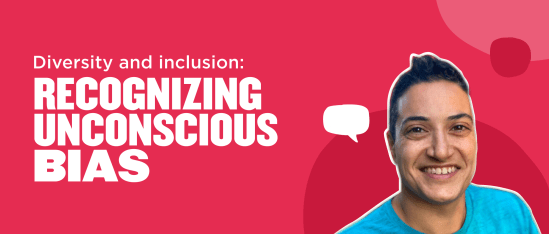**This is a guest blog post written by HiBob employee (bobber) Shani Shitrit. Shani is a parent, a non-binary and loving human, a person with a disability, an activist for human rights, a Crossfit athlete, and a former Wheelchair basketball player.
DE&I has become a hot topic around the world, from schools to informal social gatherings to workplaces. There have been amazing strides in the right direction, and people are now very conscious of other people’s needs and the benefits of diversity and inclusion.
There’s a ton of material about how to implement best practices for DE&I, but attending a lecture or participating in Pride Month isn’t enough. To achieve significant change, we need to understand the root causes of our biases.
The origin of bias
Everyone everywhere has bias. Our biases are rooted in our beliefs, upbringing, experiences, and instinctive reactions to those experiences. We all grow up in biased societies with ranks, divisions, and roles.
People of different racial and ethnic backgrounds have unique experiences in society, as do people with disabilities. Experiences can also be personal. The way people treat us can be based on their biases about the racial, ethnic, or other groups we belong to.
We all assume certain things about people based on age, political affiliation, gender and sexual orientation, and so many other things. Bias is one of the ways our mind creates “shortcuts”: It creates stereotypes and characteristics, and those guide us in everything we do and think without us even knowing.
Modes of thinking are ingrained in our subconscious. Because of this, many of us aren’t aware of our biases and how they affect our behavior. This is called unconscious bias.
How can we become aware of our unconscious bias?
Picture a C-level job position in a company you admire.
Who do you see filling this role? What gender is the person you pictured? What’s their ethnicity? Are they disabled?
Western society’s stereotypical image of a successful person is a young, cisgender white man. Most of us probably didn’t picture a person with a disability, and we probably didn’t imagine them as queer or Black, either.
This short exercise shows how biases limit and direct our thinking. We might be educated and support diversity in business, but we still instinctively picture cisgender white men when we think of CEOs and people in other successful roles. Our instincts, belief systems, and actions are not aligned because of our unconscious biases.
Acknowledging our biases empowers us to reshape our thinking and actions and make positive changes.
How does bias influence company culture?
Biases influence our ability to connect with others who seem different from us and prevent us from empathizing with their experiences. Eradicating our biases allows us to accept more people, increases our ability to collaborate with others, and helps foster more inclusive work cultures. When we talk about culture, we need to discuss workplace atmosphere, rights, values, and ethics because bias influences equality and fair opportunities.
Society has come a long way in recent decades. Brave people have fought against bias, inequity, and inequality, and countries around the world have passed laws that guarantee minority, LGBTQ+, and women’s rights, but workplace cultures often don’t reflect this.
Let’s look at a common example:
We might have an unconscious bias about people with disabilities. We might think they won’t make good managers because we assume their unique needs disrupt their performance. We might also assume that we have to make special adjustments to our processes and company/team activities to suit their needs.
If we’re aware of our biases and catch ourselves thinking like this, we can choose to behave differently. We can train ourselves to naturally consider people with disabilities for the promotions they deserve and simply ask what they need to succeed. We might find that they ask for additional professional training like anyone else and that it’s easy for the organization to support any special adjustments or requests.
An organization’s culture starts with its people
When HR leaders and managers make an effort to acknowledge bias, it can help organizations increase awareness and think more inclusively. When we’re bias-aware, we have more control over the choices we make and can start actively nurturing healthier work environments as a community.
Adopt inclusive hiring practices
HR leaders and hiring managers need to set the example and encourage diversity and acceptance throughout every person’s employee lifecycle. If you’re recruiting, asking yourself and candidates these questions will put everyone on more inclusive ground from the get-go:
- Are you willing to learn new things about yourself and your colleagues?
- Are you ready to examine your behavior and challenge your assumptions about others?
Encourage inclusivity from within
Use anonymous surveys to ask your people how inclusive they feel your organization is in terms of:
Rights
Does your company provide mental health resources? Do you offer comprehensive health benefits for LGBTQ+ people and couples?
Unique needs
Do some people need to work standing up? Do they have physical limitations, commuting issues, child care concerns, etc.? Does the company address these needs? Does the company provide flexible work hours for parents or allow WFH for COVID-vulnerable and higher-risk population groups?
Race and ethnicity
Does everyone at your company feel represented? Do they feel comfortable talking about sensitive topics like BLM or religious practices with their peers?
Recommended For Further Reading
Political affiliations
Do people in your organization feel comfortable and free to voice their opinions without receiving backlash?
Use the feedback to encourage change from within and use it as a basis for your DE&I initiatives. If your organization has a DE&I Manager, they can ensure more equity and accessibility across your company.
Overcoming unconscious bias at work takes a village
When people form authentic and respectful relationships, even when our experiences and perspectives are different, we build mutual respect and the foundations of a genuinely inclusive workplace community. Mutual respect comes from awareness of our biases and our willingness to work together. To create a culture of true inclusivity, we all need to change our behaviors and thought processes for the better.

From Shani Shitrit
Shani is a parent, a non-binary and loving human, differently-abled person, an activist for human rights, a CrossFit athlete, and a former Wheelchair basketball player.

